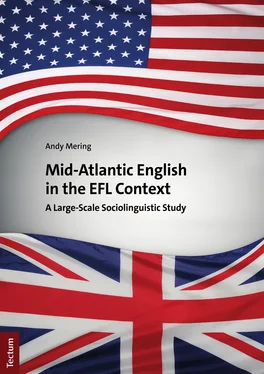The next sub-chapter will provide a brief critical synthesis of selected available research in the specific context of the ‘MAE’ paradigm.
Selected Critical Review
What are pupils’ attitudes to BrE and AmE and what is their linguistic behaviour towards them?
Thörnstrand (2008) conducted a questionnaire-based study with 108 upper secondary students from schools in the Stockholm area. Her one-and-a-half-page long questionnaire addressed lexical, phonological, and orthographic contrasts between BrE and AmE. As to the vocabulary part of the questionnaire, Thörnstrand formed 10 sentences in Swedish. They included lexical items which students were supposed to translate from Swedish into English.
With the aim of exploring whether school students’ pronunciation is affected by AmE, Thörnstrand’s informants were requested to read out a very short text she composed. Each sentence contained words that represented some most common pronunciation differences between BrE and AmE. The main finding of Thörnstrand’s study showed that her informant group of upper secondary students have a tendency to prefer AmE more than BrE in the language areas of lexis and phonology. In her opinion, this is ascribable to exposure to AmE through TV programmes and films. Another finding was that the number of students who mixed both varieties was unexpectedly high, according to her. This stands in stark contrast to the results for the three tested spelling items, which focused on one divergent spelling variable between BrE and AmE ‘-ou/-o’. The survey indeed revealed that more than 60 % of the participating boys and girls opted for the BrE spelling.
Whilst perusing Thörnstrand’s questionnaire-survey, several aspects of it beg critique. The first critique applies to one aspect of her research method: her students had to translate the suggested variables from Swedish into English. I hold the view that this is not a reliable research method. She herself acknowledges in the conclusion that it compromised the validity of the questionnaire because the students had a “smaller vocabulary” than she had imagined (2008, p. 20). With respect to Thörnstrand’s choice of 15 lexical variables, one of them nevertheless elicits critical comment. According to her, ‘taxi’ is BrE and ‘cab’ AmE. Although Americans prefer the term ‘cab’, both are used in the two main varieties (Horlacher & Hough, 1978, p. 32). It might be suspected that ‘cab’, short for ‘taxicab’, used to be an Americanism but became adopted in BrE and is as such not an appropriate variable for a study on ascertaining how AmE lexis influences current NNSs’ English.
Finally, mention should be made of Thörnstrand’s research reliability regarding the monitoring of her survey population’s pronunciation. She concedes that her study solely centred on students’ pronunciation of vowels, in particular the BATH vowel. Other segmental BrE and AmE contrasts, for example, T-voicing and Yod-dropping were not under investigation. Likewise, variations of stress placement between the two main varieties were not considered in her investigation either. Yet, the inclusion of stress patterning in Thörnstrand’s investigation would assuredly have provided a more accurate assessment of differences between BrE and AmE in her informants’ pronunciation.
What is pupils’ degree of lexical and orthographic preference of BrE and AmE and what are their attitudes to the two main varieties?
Söderlund and Modiano conducted a questionnaire-survey in 1999 in a Swedish upper secondary school. As many as 282 students participated and they came from several grades to meet the criterion of representativeness in relation to different levels of proficiency (Modiano, 2002, p. 151). The researchers focused on spelling and vocabulary but included a short attitudinal part in order to find out students’ attitudes to and perceptions of BrE and AmE. They also provided the students’ teachers with a short questionnaire to ask them which variety they prefer and which one they use in their teaching (Modiano, 2002, p. 150). The survey also contained a listening session, which was composed of two parts and conducted before students had to complete the other parts of the questionnaire. In the listening part of the questionnaire, firstly students’ perception of a mixed use of BrE and AmE was targeted. To this end, a short sequence of an MTV video-jockey 5, who spoke with a ‘MAE’ accent, was played. Students were asked to answer with “yes” or “no” whether they would like to speak like him, they felt it is easy to understand, and if this ‘MAE’ speech pattern was easier to comprehend than “other English models” (Modiano, 2002, p. 169). Secondly, the researchers’ young informants were supposed to listen to the pronunciation of seven words both in BrE and AmE and had to decide which pronunciation they heard first, and which comes second.
Concerning the global research results, the authors achieved an empirical-based understanding that school students are significantly under the influence of AmE. The authors assert that “there is a tendency to use AmE lexical items as well spelling conventions more often than their BrE alternatives” (Modiano, 2002, p. 167). The findings of the teachers’ questionnaire were also revealing: they claimed that they use BrE in their teaching but their “preferred variety of English was shared between BrE and MAE” (Modiano, 2002, p. 167).
After carefully examining Söderlund’s and Modiano’s quantitative questionnaire-survey, some aspects of their methodology can be challenged. As regards their investigation of the lexical and orthographic area, the suggested translation may not ideally account for research reliability. A more optimal data collection method could consist of the monitored lexical and orthographic items being inserted into a clear textual context. This was my underlying rationale for the questionnaire design. In addition, the researchers’ investigated spelling variables of BrE ‘programme’ and AmE ‘program’ are problematic. As can be seen in the Cambridge Advanced Learner’s Dictionary (henceforth abbreviated to CALD), current BrE also employs ‘program’, but in relation to computer programs (CALD, 2013, p. 1224). Furthermore, the spelling items ‘hypnotise’ (BrE) /’hypnotize’ (AmE) might be regarded as being variables with little reliable research potential in terms of spelling variation. Students are probably more familiar with the verb pairs ‘organising’ (BrE) /’organizing’ (AmE), for example.
The authors’ choice of lexical variables equally calls for a few remarks. The putative BrE ‘bathing suit’ and its AmE counterpart ‘swimming suit’ are not likely to offer particularly wise variable choices for empirical scrutiny. ‘Bathing suit’ is old-fashioned in the UK or an AmE lexical item (cf. CALD, 2013, p. 119). The tested BrE ‘Father Christmas’ vs AmE ‘Santa Claus’ word pairs merit some critical comment as well. ‘Santa Claus’ is not a current Americanism, although it was originally a US usage from dialectal Dutch ‘Sante Klaas’, ‘St Nicholas’ (cf. Mencken, 1936, p. 109). It is crucial, in this context, to bear in mind what Tottie posited in respect of the ephemeral nature of Americanisms: “What was an Americanism yesterday may well be perfectly normal British English today, especially in the area of vocabulary…” (Tottie, 2002, p. 3). As to the researchers’ use of terminology, they seem to regard ‘concept’ and ‘variety’ as synonyms for the description of a mixed usage of BrE and AmE. As ‘MAE’ has not undergone the processes of expansion of function, nativisation of linguistic structures and institutionalisation, the tendency of mixing features of BrE and AmE cannot be recognised as having variety status (cf. Mollin, 2006, p. 52). Several empirical studies across Europe would need to be pursued with the aim of vindicating the designation ‘MAE’ variety.
Читать дальше












